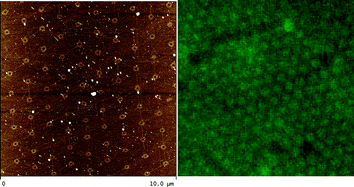Aminofunctionalization and sub-micrometer patterning on silicon through silane doped agarose hydrogels
Abstract
Agarose based hydrogels doped with

* Corresponding authors
a
Centro de Investigaciones Biomédicas en Red, Biomateriales, Bioingeniería y Nanomedicina (CIBERbbn), Departamento de Física Aplicada y Departamento de Biología Molecular, Facultad de Ciencias, Universidad Autónoma de Madrid, 28049 Cantoblanco-Madrid, Spain
E-mail:
miguel.manso@uam.es
Fax: +34 914973969
b Dipartimento di Chimica, Università degli Studi di Catania, V.le Andrea Doria, 6, Italy
c Instituto de Ciencia de Materiales de Madrid, Consejo Superior de Investigaciones Científicas CSIC, 28049 Cantoblanco-Madrid, Spain
Agarose based hydrogels doped with

 Please wait while we load your content...
Something went wrong. Try again?
Please wait while we load your content...
Something went wrong. Try again?
M. Manso Silván, G. M. L. Messina, I. Montero, C. Satriano, J. P. G. Ruiz and G. Marletta, J. Mater. Chem., 2009, 19, 5226 DOI: 10.1039/B903820E
To request permission to reproduce material from this article, please go to the Copyright Clearance Center request page.
If you are an author contributing to an RSC publication, you do not need to request permission provided correct acknowledgement is given.
If you are the author of this article, you do not need to request permission to reproduce figures and diagrams provided correct acknowledgement is given. If you want to reproduce the whole article in a third-party publication (excluding your thesis/dissertation for which permission is not required) please go to the Copyright Clearance Center request page.
Read more about how to correctly acknowledge RSC content.
 Fetching data from CrossRef.
Fetching data from CrossRef.
This may take some time to load.
Loading related content
